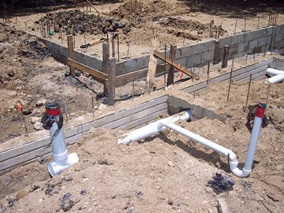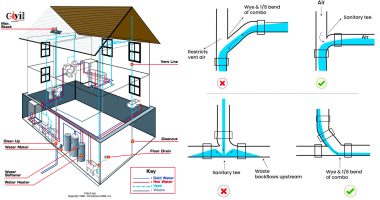The Core Elements of Your House's Plumbing System
The Core Elements of Your House's Plumbing System
Blog Article
Just how do you really feel on the subject of Plumbing Installation 101: All You Need to Know?

Understanding exactly how your home's pipes system works is essential for every single house owner. From delivering clean water for alcohol consumption, cooking, and showering to safely removing wastewater, a well-kept plumbing system is important for your family's health and wellness and comfort. In this thorough guide, we'll check out the intricate network that composes your home's plumbing and deal ideas on upkeep, upgrades, and managing usual problems.
Intro
Your home's pipes system is greater than simply a network of pipes; it's an intricate system that ensures you have access to tidy water and efficient wastewater removal. Recognizing its parts and just how they work together can help you stop pricey fixings and ensure whatever runs efficiently.
Standard Elements of a Pipes System
Pipes and Tubing
At the heart of your plumbing system are the pipes and tubes that lug water throughout your home. These can be constructed from various materials such as copper, PVC, or PEX, each with its advantages in terms of toughness and cost-effectiveness.
Components: Sinks, Toilets, Showers, etc.
Fixtures like sinks, toilets, showers, and tubs are where water is utilized in your house. Recognizing just how these fixtures connect to the plumbing system aids in diagnosing problems and planning upgrades.
Valves and Shut-off Points
Valves manage the flow of water in your plumbing system. Shut-off valves are essential during emergencies or when you need to make repair services, allowing you to separate parts of the system without interfering with water circulation to the whole home.
Water System
Main Water Line
The main water line links your home to the local water supply or an exclusive well. It's where water enters your home and is distributed to numerous fixtures.
Water Meter and Pressure Regulatory Authority
The water meter measures your water use, while a stress regulatory authority guarantees that water streams at a risk-free pressure throughout your home's pipes system, protecting against damages to pipes and components.
Cold Water vs. Warm water Lines
Recognizing the difference between cold water lines, which provide water directly from the main, and warm water lines, which lug warmed water from the water heater, aids in fixing and planning for upgrades.
Water drainage System
Drain Pipes Pipeline and Traps
Drain pipelines carry wastewater far from sinks, showers, and commodes to the drain or septic system. Traps prevent drain gases from entering your home and likewise trap particles that can trigger obstructions.
Air flow Pipelines
Ventilation pipes allow air into the drainage system, stopping suction that can slow down drainage and create catches to empty. Proper ventilation is necessary for preserving the stability of your plumbing system.
Importance of Correct Drain
Ensuring correct drain prevents back-ups and water damage. Regularly cleaning up drains pipes and preserving traps can stop expensive repairs and prolong the life of your plumbing system.
Water Furnace
Kinds Of Water Heaters
Water heaters can be tankless or typical tank-style. Tankless heating units heat water as needed, while storage tanks save heated water for instant usage.
Updating Your Plumbing System
Reasons for Upgrading
Updating to water-efficient fixtures or changing old pipelines can boost water top quality, lower water expenses, and enhance the worth of your home.
Modern Pipes Technologies and Their Advantages
Explore innovations like clever leak detectors, water-saving bathrooms, and energy-efficient water heaters that can save cash and lower ecological impact.
Expense Factors To Consider and ROI
Determine the upfront costs versus lasting cost savings when taking into consideration pipes upgrades. Numerous upgrades spend for themselves with decreased energy expenses and less fixings.
How Water Heaters Attach to the Pipes System
Recognizing exactly how hot water heater connect to both the cold water supply and hot water circulation lines assists in identifying issues like insufficient hot water or leaks.
Maintenance Tips for Water Heaters
Consistently purging your hot water heater to eliminate sediment, inspecting the temperature settings, and examining for leaks can prolong its life-span and boost power performance.
Usual Pipes Problems
Leakages and Their Causes
Leakages can happen because of aging pipes, loose installations, or high water stress. Resolving leaks promptly avoids water damage and mold development.
Blockages and Obstructions
Clogs in drains pipes and bathrooms are typically triggered by flushing non-flushable things or a build-up of grease and hair. Using drainpipe screens and bearing in mind what drops your drains pipes can avoid clogs.
Indicators of Plumbing Troubles to Look For
Low water stress, sluggish drains pipes, foul odors, or abnormally high water expenses are indicators of prospective plumbing issues that ought to be addressed without delay.
Plumbing Maintenance Tips
Routine Evaluations and Checks
Set up yearly plumbing assessments to catch concerns early. Search for indications of leaks, deterioration, or mineral accumulation in taps and showerheads.
DIY Upkeep Tasks
Basic tasks like cleaning tap aerators, looking for bathroom leaks using color tablets, or insulating revealed pipelines in chilly environments can stop significant pipes concerns.
When to Call a Specialist Plumbing Technician
Know when a pipes issue requires expert competence. Trying complex repair services without proper expertise can lead to even more damages and higher repair expenses.
Tips for Lowering Water Usage
Straightforward habits like dealing with leaks quickly, taking shorter showers, and running complete lots of laundry and meals can preserve water and lower your utility expenses.
Eco-Friendly Plumbing Options
Think about lasting plumbing materials like bamboo for floor covering, which is durable and eco-friendly, or recycled glass for countertops.
Emergency situation Preparedness
Steps to Take During a Pipes Emergency situation
Know where your shut-off valves are located and exactly how to switch off the supply of water in case of a ruptured pipeline or significant leak.
Significance of Having Emergency Situation Calls Handy
Maintain call details for local plumbing technicians or emergency situation solutions conveniently available for quick action throughout a pipes situation.
Environmental Impact and Conservation
Water-Saving Fixtures and Devices
Mounting low-flow taps, showerheads, and toilets can substantially lower water usage without sacrificing efficiency.
Do It Yourself Emergency Fixes (When Appropriate).
Momentary repairs like making use of air duct tape to spot a dripping pipeline or placing a bucket under a dripping faucet can minimize damage until an expert plumbing technician gets here.
Conclusion.
Understanding the composition of your home's pipes system encourages you to keep it successfully, conserving money and time on repairs. By complying with regular maintenance regimens and remaining educated concerning modern pipes innovations, you can ensure your pipes system operates efficiently for years to come.
HOW YOUR PLUMBING SYSTEM WORKS
Which Pipes Do What?
Blue lines = fresh water supply entering the building Red lines = hot water supply entering the building Grey lines = pipes carrying waste away from the building and venting pipes carrying gases away from the building (through the roof) YOUR MAIN PLUMBING SYSTEMS
There are two main plumbing systems that support your home s basic plumbing needs one that brings clean water into your home, and one that sends dirty water away from your home. Connected to the toilet, bath, shower, and other faucets in your home, these two systems keep your water flowing in the right directions.
ACCESSING FRESH WATER
Fresh and clean water is brought into your home through the main water supply line . Filtered through one pipe, this water is pressured to flow into the various fixtures in your home at any given time.
This water can be sourced from a well located on your property, a pond or river (mostly cottages), or, as in most cases, from the city s municipal water treatment centre. However, it is important to note that water that is untreated, such as the water siphoned from ponds or rivers, may not be safe to drink. Personal water supplies always need to be treated for hardness and contaminants before consumed.
MUNICIPAL WATER SUPPLIES
Improve taste and odour Remove sediment Eliminate hardness Reduce chlorine COLD WATER SUPPLY VS. HOT WATER SUPPLY
Cold water flows into your home or building through the service line, which then distributes hot or cold water to your fixtures. This line is most commonly run through a central column that runs floor to floor. Hot water runs in short and straight pipes as the longer the pipeline, the more heat that will be lost in the transfer. Having shorter pipes also allows residents to access hot water more quickly.
WASTE WATER SYSTEM
Your wastewater system is divided into two parts pipes that send wastewater away from your home and venting pipes that send sewer gas away from your home. Sewage water travels through pipes that flush the water and waste towards local sewers that are operated and managed by your city or town. Most sewer systems rely on gravity to move the wastewater to where it needs to go.
The further away from your toilet or sink, the larger wastewater pipes become. This allows for waste to be disposed of from various parts of your home or business at once without pipe blockages. The angle and flow of these pipes are also essential for keeping your waste pipes clear of build up.
https://harrisplumbing.ca/how-your-home-plumbing-system-works/

I hope you enjoyed reading our section about Plumbing Installation 101: All You Need to Know. Thanks a ton for finding the time to read through our article post. Enjoyed our piece of writing? Please quickly share it. Let another person locate it. Thank you for your time spent reading it.
Details Report this page